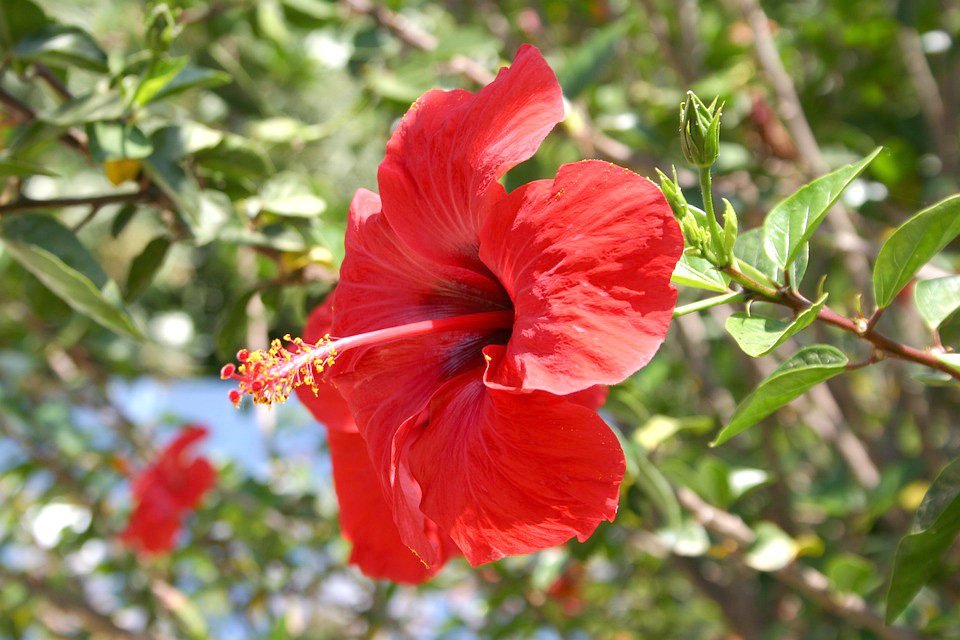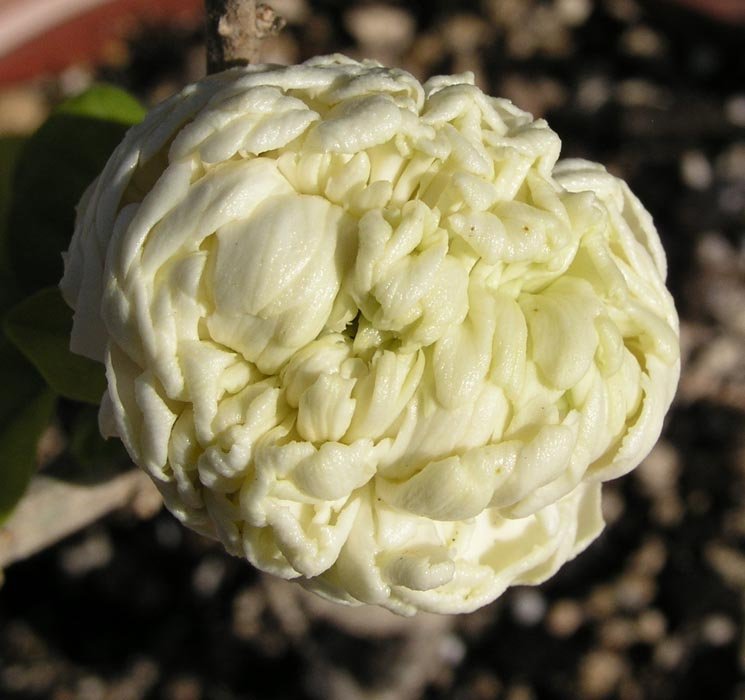A highly evening-perfumed plant that immediately comes to mind is Cestrum nocturnum, known in Cyprus as ‘Pakistani Nights’, but originally from the West Indies. It is sometimes known as the ‘Night-flowering Jessamine’, although it is not related to that family, but is a member of the Solanaceae family, so take care when handling it. This evergreen shrub has greenish-white tubular flowers that are usually pollinated by moths. The petals remain closed until the evening, when they open up and exude their heady perfume, which can be so strong that people with respiratory problems are sometimes affected. Some say that its perfume is the most powerful in the plant world.
Nicotiana sylvestris, a native of Argentina and Bolivia, and in some countries known as. the ‘woodland tobacco plant’, is another member of the same family. The tall stems towering above the leaves cascade into a starburst of long white flowers. The fragrance is especially strong in the evening, so as to attract pollinating moths. We all love lightly-perfumed petunias, in the same family incidentally, and although highly regarded in the western world, their origins were in South America as well. What would we do without them, adorning our window boxes and courtyards with their cheery flowers in a multitude of colours.
Jasmines are well known for their perfumes. A popular jasmine in many gardens here is Jasminum officinale, also known as ‘Spanish Jasmine’, ‘Catalonian Jasmine’ or ‘Royal Jasmine’ and even ‘Poet’s Jasmine’! Despite these common names, this jasmine originally came from South East Asia and is related to the olive family. It is a rampant grower, covering arches and pergolas in no time at all and putting on as much as three metres in a season. It looks charming over an umbrella-shaped support, so that the long stems drape elegantly downwards. The climber really benefits from heavy pruning right back to the old wood in the late winter or early spring. If you are not severe with the pruning, then there will not be any flowers, as the old leaves and stems will die back during the summer. The flowers appearing on the ends of the new stems are quite large and very fragrant with a pink blush on the outside.
Hoya carnosa, also known as the ‘Honey Plant’ or ‘Wax Plant’, is a lovely climbing plant and a native of Eastern Asia and Australia. It has very fleshy leaves and extremely pretty pink star-shaped flowers that appear on leafless spurs. The night-scented flowers are attractive to insects but do not set seed. When the flowers die it is important not to cut off these spurs, as new flowers will appear in the same place next season. Growth can be as much as two metres so it important to give the plant a support or trellis for it to climb up. Do not over-water this plant, especially during the winter, when you should let the compost dry out before watering again. Propagation is by layering or stem cuttings.
Stephanotis, from Madagascar, is a particular favourite of mine and the crowning glory of this heavily fragrant climber, are the waxy-white flowers that appear on new growth. Usually when you buy this plant, the stems are twined around a circular support and when the flowers are in bloom they really look like a bridal wreath, hence it’s common names of ‘Bridal Veil’ or ‘Bridal Wreath’. Their heady perfume is intoxicating.
Whilst datura and brugmansia are not native to these shores either, both share their evening scented flowers with us. However, great care should be taken when tending them as they are poisonous, so wear latex gloves and lots of hand washing after handling them. We are so lucky to be able to be able to grow these plants from so many foreign lands here that give us such pleasantly perfumed evenings during the summer.
WHAT TO DO IN THE GARDEN THIS MONTH

Some would say as little as possible and that seems a good idea, especially when it is hot and all you want to do is laze around the pool or be at the beach!
How quickly the months have passed in these strange times this year and whilst tourists would normally be flocking to enjoy the Cypriot sunshine, those with gardens here know that this is a time of high maintenance. Any watering should be done in the cool of the evening, and if you have a computerised watering system, set it to work during the night, when it will do most good. Watering potted plants is a different matter. You can link them to your watering system of course with spaghetti feeders, but generally speaking you are going to have to water them by hand. Move them if you can, under trees is ideal, or if you don’t have trees find a sheltered spot for them. Placing them on a tray of small pebbles before watering will provide some humidity, which many plants thrive on.
Even though the garden is barely ticking over and growth is slow, there are bugs out there to wage war on. Lots of Med flies are looking for somewhere to lay their eggs. They need soft skins on fruits to be able to penetrate and lay them and if any of your oranges or grapefruit are colouring up at all, they will be in there! Hibiscus rosa–sinensis really does attract those nasty mealy bugs, so keep a close eye on then. Like many tropical plants, hibiscus flowers last for only one day so remove any dead flowers on a daily basis, which will allow you to check for mealy bugs. If they are only just appearing then you can squash them between your finger and thumb, but in recent years there have been so many serious infestations around the island that more drastic measures may need to be taken. Last summer (2019), we tried a new method of getting rid of them by mixing 3ml Movento and 30ml Insectoil Key in 5 litres of water and spraying the offending mealy bugs, including under the leaves and stems. Keep a watch out for any more bugs over the next few days and it may be necessary to spray once more, but this should deal effectively with them. Both products are available at garden chemical shops or Solomou Garden Centre in Nisou.
If you live in a rural area, keep a look out for any young snakes during these hot summer months. They like to lie on warm stones and drowse in the heat. They can also lurk under bushes and shrubs, so take care when clearing out old leaves from beneath them. If you keep the area under plants free from debris, not only will it deter them from hiding there, stop any fungal growth from appearing and more importantly it will allow water to reach down to the roots of plants where it does the most good.
Main crop figs are ripening fast now, so check every day and pick any that look as if they are nodding their heads, which is a sign that they are ready to be picked. Vines, which always look so lush, even in the height of summer, will have many bunches of grapes hanging down. Check the bunches regularly and remove any fruit that doesn’t look perfect.
Enjoy the summer and don’t try to do too much. It can all wait until the weather cools down, which according to custom here should be after Maria’s Assumption on August 15.
PLANT OF THE MONTH – JASMINUM SAMBAC

Foulli (Jasminum sambac) can be a little tricky to grow and not everyone can get them to produce flowers. The old Cypriot way to grow them was to plant them in an old oil drum, filled with earth from the base of a carob tree and left to get on with it! If you do not have a carob tree handy, try a good quality humus-rich, slightly acidic compost instead, but keep the plant reasonably dry, as it detests wet conditions. Try feeding with a balanced fertiliser once a month during the summer months (that is the one where all the numbers on the back of the packet are the same, such as 7-7-7). If it is happy where it is growing, it can reach 3 metres. Some varieties have double flowers but all smell heavenly on the evening breezes. Prune after flowering to keep the bush in shape. Pests and diseases are not usually much of a problem with this plant, but it is important to be aware of the ones that most affect them. White flies, scale insects and mealy bugs may land on these plants, but can usually be controlled by mechanical or chemical means. If the surface of your foliage is turning black with a soot-like mould, this could be the excreta of sap sucking insects, usually a good indication that one of these pests may have made a home on your plant!
Patricia Jordan


